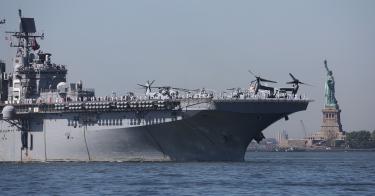Our nation’s maritime strength has been ebbing for years, but few policymakers have taken notice let alone real action—until now. More and more members of Congress are speaking up, with many determined to fix what has turned into a national strategic vulnerability.
For example, Sen. Roger Wicker (R-Miss.) recently announced plans to increase defense spending by $55 billion to get industry “on a footing to deliver a 355-ship” Navy.
It’s a long-overdue change. Barely 0.4 percent of our trade is conducted on U.S. ships, leaving our security and prosperity in the hands of Chinese state enterprises that are increasingly dominating every aspect of maritime activity. To reduce our overreliance on unfriendly nations, Congress must revive a critical industry that will require action in workforce, shipyards, shipbuilding and shipping.
Regaining American competitiveness is key. A successful renaissance in American shipping will allow us to build momentum and set conditions for a sustained revival in America’s maritime industry. This will require five things.
>>> We’re All Living… With One Less Submarine
One, end dealmaking with Chinese Communist Party controlled maritime entities. Some lawmakers have advocated proposals that would phase in prohibitions on Chinese shipyards conducting construction or repairs on U.S. owned or flagged vessels. Never mind phasing them in—those provisions should be made active immediately.
Two, seek common cause with allied maritime nations to secure a global environment conducive to fair competition and conducive to an American maritime revival. To secure a business environment free of Chinese state-sponsored predation requires a Maritime Group of Nations to coordinate regulatory and financial policies. It’s time for a G7 in shipping and shipbuilding—a so-called M9.
Three, create a compelling environment for investment in America’s waterfront communities and shipyards. Creation of maritime prosperity zones is one way to attract investment (even from allies) that is overdue and welcome to expand existing and build new shipyards and ports.
Four, encourage Americans to enter, innovate, and grow the maritime sector and develop lucrative opportunities for more Americans. Of course, if there are no jobs to go, then training mariners, building up a maritime workforce, and attracting the best engineers to naval architecture will be for naught.
Five, secure adequate shipping today for a crisis and potential war. This is vital to sustain military operations and a wartime economy. There is urgency to act given the danger of a war this decade, but it also ensures jobs for Americans entering in larger numbers the maritime sector.
>>> It’s Past Time to Re-Supply Our Munitions-Depleted U.S. Navy
But this cannot just be more of the same old policies: cargo preferences, the Maritime Security Program, and the Tanker Security Program without incentives for innovation in shipbuilding. If tied to a reimagined national security construction differential, ships with American future-proofing modifications could serve to kickstart a revolution in shipping. This would foster an American comparative advantage and greater market share of the global maritime sector.
There is no free lunch, of course, but the cost of this endeavor can be borne smartly. One way is creating a maritime security trust fund funded through increased port user fees to non U.S. flagged ships, tariff Chinese shippers who support their military.
Our leaders must act with vision and a comprehensive approach that encompasses the five concerns above. Doing this, our nation can lead a revolution in shipping and close off our nation’s maritime strategic vulnerability.
This piece originally appeared in the National Security Journal





